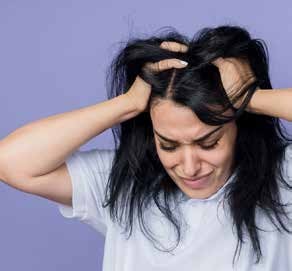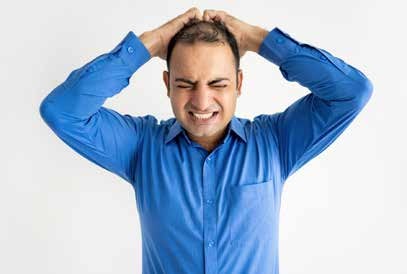The Stress Connection
Dr Pradnya Manwatkar details the intricate link between stress, hair loss, and modern treatment approaches in aesthetic dermatology.
Women, and most men these days, can’t have enough hair on their heads. Losing one hair strand can evoke a sense of urgency, but imagine losing 10 or even more than a hundred! Hair loss is a natural occurrence for both men and women. Hair, particularly in India, holds a significant historical and anthropological context (Berg 1951; Hershman 1974). Its symbolic, religious, personal, ethnic, and gendered meanings in South Asia are well-documented (Hiltebeitel and Miller 1998), just as they are across the globe (Sherrow 2006). A full head of hair is universally considered important, regardless of race or gender, adding to an individual’s beauty. Distress follows when beauty feels threatened.
Furthermore, any physical or psychological distress the body undergoes can result in hair fall, perpetuating a vicious cycle of treating either the distress or the hair-fall first.
Addressing hair fall becomes paramount, even a minor decrease in its rate can significantly alleviate the patient’s distress. Modern aesthetic dermatology has made significant strides in providing relief. Diagnosis is the first step toward treating the patient. A patient might suffer from acute telogen effluvium (ATE) due to infections or fad dieting, or chronic telogen effluvium (CTE) because of poor nutrition, low hemoglobin, or an unhealthy lifestyle.
Correcting these causes helps alleviate hair fall. Treatments like Oral Cyclical nutrition, Growth Factor Concentrates, Platelet Rich Plasma, and Dermarollers, help in reducing hair in the telogen phase and improving the anagen phase of the hair cycle. Androgenetic alopecia (AGA) cases can benefit from oral and topical minoxidil, significantly altering the existing thinning pattern and comforting the patient. However, these treatments are time-consuming because hair follicles undergo a lifecycle comprising three phases: anagen (growth), telogen (resting), and catagen (transitional). Although treatments can enhance the anagen phase, the telogen phase typically lasts for three months. Thus, for treatments to show effects, three months is required. Unfortunately, if hair fall results from autoimmunity conditions like Lichen planopilaris (LPP), lupus (DLE), or alopecia areata (AA), hair regrowth is challenging due to the scarring nature of these conditions.
The next step involves treating the stress causing the hair fall and the stress resulting from the hair fall. Ample studies link cortisol levels to hair fall. A recent study by Dr Ya-Chieh Hsu of Harvard University, published in Nature on March 4, 2021, investigated the underlying mechanisms connecting stress and hair loss.

The researchers initially tested the role of adrenal glands, which produce key stress hormones – corticosterone in rodents and cortisol in humans. Removing the adrenal glands from mice led to rapid cycles of hair regrowth, unaffected by age-related slowdown, unlike control mice. Mild stress on mice over weeks increased corticosterone levels and decreased hair growth. Hair follicles remained in an extended resting phase. These findings supported corticosterone’s role in inhibiting hair regrowth. Further investigation revealed that corticosterone did not directly regulate stem cells. By deleting the receptor for corticosterone from different cells, scientists determined that the hormone acts on a cluster of cells beneath the hair follicle called the dermal papilla. It reduces the activity of the papilla by decreasing the GAS6 that activates hair follicle stem cells.

Although the studies were conducted in mice, the existing Neuro Immuno Cutaneous Endocrine (NICE) system links distress to elevated cortisol and adrenaline levels. Anxiety can lead to a dysregulated NICE, while depression can decrease serotonin and oxytocin levels. Hence, Emodermatology (REBTbased psychological counseling) becomes crucial. It heightens patient awareness of thoughts to regulate the NICE system in the long run. Alongside counselling, oral medicines like low-dose amitriptyline for anxiety or low-dose escitalopram for depression offer better and more sustainable treatment outcomes.
The era of using the term ‘idiopathic’ (where the cause of a disease is not clear) is long gone. In today’s age, where the skinbrain connection is well-established, patients deserve a holistic line of treatment. Aesthetic dermatology and cosmetic trichology offer excellent solutions, but to ensure their longevity, they need to be complemented by emodermatology.
About the author: Dr Pradnya Manwatkar, Consultant Dermatologist and Cosmetologist, Skin Matra, is based in Mumbai and author of the books ‘How To Tell Your Skin To Heal Itself’ and ‘From Skin Breakouts to Skin Breakthroughs’. She has completed her training hours in REBT -Rational Emotive Behavioural Therapy, and actively counsels her patients to ensure better treatment outcomes. Her expertise lies in emodermatology, and latest treatments along with counselling that ensure long-lasting treatment outcomes.